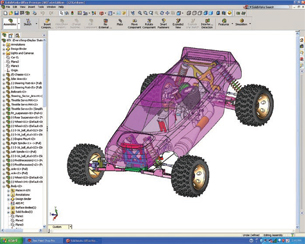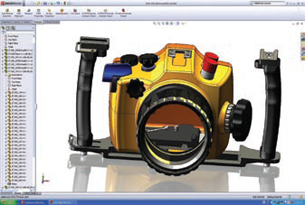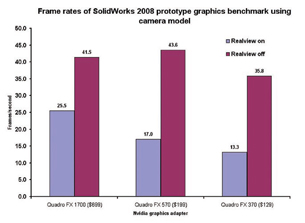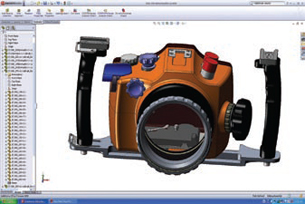Which Graphics Card Is Right for Computer Aided Design?
When users of 3D CAD software start talking about buying a new high-performance computer, they often ask which graphics card is the best.
Latest News
November 1, 2008
By L. Stephen Wolfe
 The SPEC APC benchmark uses this assembly model of a car to exercise various functions inSolidWorks 2007. It is one of the more recent APC benchmarks for industrial CAD. |
When users of 3D CAD software talk about buying new computers, they often ask which graphics card is best. Today’s graphics adapters are circuit boards containing graphics processing units (GPUs) that plug into the PCI Express bus of desktop computers. GPUs accelerate the translation and rotation of shaded 3D models. Without them, zooming and rotating large, complex models can be a jerky, frustrating experience.
Graphics cards are the subject of intense competition with AMD’s FireGL and NVIDIA’s Quadro FX models engaged in a pitched battle for the so-called “professional” graphics adapter market. In contrast, Intel so dominates the market for computer central processors (with AMD a distant second) that it doesn’t spend nearly as much on marketing hype.
Graphics cards generally fall into two broad classes. Professional models are certified by CAD software makers to perform correctly using the OpenGL application programming interface (API) favored by most CAD software makers. Consumer models, such as NVIDIA’s GeForce and AMD’s Radeon lines, are intended for games using Microsoft’s Direct3D API. Years ago, professional cards cost a lot more than game cards. So CAD customers on a budget sometimes bought game cards despite warnings by CAD software vendors that these devices were not tested with CAD software.
 Model of an SLR camera case shown with SolidWorks 2008 RealView display mode enabled. Realview generates more realistic real-time material appearances, highlights,and reflections using procedural shaders. |
As games grew in graphics sophistication, gamers developed an appetite for more powerful graphics adapters. Today, cards at the low end of the professional graphics range cost less than many game cards. My sons routinely spend more on their 3D gaming cards than I do for CAD workstations.
Tests by graphics card makers using the SPECviewperf benchmarks of the Standard Performance Evaluation Corporation Graphics and Workstation Performance Group (SPEC/GWPG) indicate a substantial range of performance between the least costly professional graphics cards and those listing for $600 and up. But while SPECviewperf is fine for characterizing graphics performance, designers running MCAD software might want to take total system performance into account.
|
SPEC’s Application Performance Characterization (SPECapc) benchmarks use commercial CAD packages driven by macros (trail files or Visual Basic scripts) that exercise graphics along with central processors and main memory. The SPECapc tests generally use a mix of tasks that designers perform in a typical workday, including opening and rebuilding large models, rotating and zooming models in and out, and generating 2D drawings. Consequently, SPECapc benchmarks give more realistic comparisons of total workstation performance than the more-often cited SPECviewperf, which is limited to graphics performance. SPECapc benchmarks have been written for PTC’s Pro/ENGINEER, Siemens PLM NX, SolidWorks, and Solid Edge.
The question CAD system buyers should ask is not about scores, but whether higher priced graphics adapters justify their additional cost.
Testing
To answer this question, I tested the three lowest-priced graphics adapters in NVIDIA’s Quadro FX line. These cards were reviewed in the July 2008 issue of DE.
I ran each of the three adapters in the same workstation: a Dell Precision T3400, equipped with an Intel E8500 microprocessor, 4GB of 800 MHz DDR2 ECC SDRAM memory, a 500GB SATA disk drive, and dual PCI Express graphics buses. The Intel E8500 is a dual-core chip, operating at 3.16GHz with a 1333 MBps front-side bus. The monitor was a CRT with resolution of 1280 x 1024 pixels at an 85MHz refresh rate.
For a test suite, I ran the SPEC APC for SolidWorks 2007, one of the more recent APC benchmarks for industrial CAD software. The test results show that there is little improvement in performance when upgrading from NVIDIA’s Quadro FX 370 (with a list price of $129) to the costlier FX 1700 (which lists for $699).
The Quadro FX 370 runs the complete benchmark 3 percent slower than the FX 1700, which costs more than five times as much. The reason for the disparity between price and performance is that GPUs accelerate only a small portion of the operations performed by CAD software. Most of the work in CAD is performed by the main processor using the main memory.
 This 2008 benchmark shows that with Realview enabled, the Quadro FX 1700 delivers a frame rate about twice that of the FX 370. But can designers actually perceive the difference? |
So what is it that graphics processors actually do for CAD users? According to a SolidWorks graphics programmer who also tests workstation hardware, higher-priced GPUs accelerate real-time rendering effects, such as SolidWorks RealView. Real-time rendering enables CAD models with shiny surfaces to reflect objects in the surrounding scene and cast simulated shadows.
Even though the 2007 SPEC APC benchmark uses RealView, the models used in this test employ texture maps instead of dynamic shaders that are better able to use the GPU’s capabilities. To illustrate this point, SolidWorks provided me with a macro that runs with SolidWorks 2008 and some models created with RealView materials. These tests tumble a model rapidly and record the run time and the number of frames-per-second that the graphics card is generating.
“I don’t feel a model is sluggish until it drops below 10 frames per second, but others I have talked to say they can tell if the model drops below 20 fps, so it is definitely subjective,” a SolidWorks developer told me. For my part, I couldn’t perceive any difference between the high- and low-priced graphics card when panning and zooming RealView models.
Folks who don’t use RealView or real-time shading provided with other CAD software will see little benefit from more expensive graphics adapters. As the graph above shows, the frame rate of the least costly graphics adapter is not much lower than those of the more costly adapters when the RealView display mode is turned off.
Adding larger or multiple displays taxes the GPU slightly, but not enough that you’d notice. Upgrading from 1280 x 1024 pixels to 1680 x 1050 pixels (a popular size for flat-panel screens) slowed the frame rate of the FX 570 by 2 percent on the SolidWorks 2008 benchmark even though the pixel count rose by 35 percent. Adding a second monitor reduced the frame rate by 15 percent.
With the SPEC APC test for SolidWorks 2007, the overall execution time rose by 11 percent with two monitors. The graphics component increased 12 percent and the CPU component rose 15 percent.
Although these tests were performed with SolidWorks, the general conclusions drawn from them are probably valid for other feature-based CAD systems, such as Dassault Systèmes’ CATIA V5, NX, Pro/ENGINEER, Solid Edge, and Autodesk’s Inventor. If planning an exceptionally large purchase, it’s wise to run your own tests with the applications your company uses. SPEC plans to release new APC benchmarks for PLM NX5, and 3ds Max 2009 and Maya 2009 this fall and winter.
The bottom line is that if you’re buying workstations for typical CAD users who make 3D models or drawings of them or who run mechanical analyses, you don’t need a costly graphics adapter. Buy the least expensive model that’s certified to work with your software. Even if workers occasionally make ray-traced renderings using mental ray or Lightworks, a faster graphics card won’t speed up the process. A quad-core CPU may speed up batch-rendering software, but most quad-core processors run at lower clock rates than their dual-core cousins. High clock rates reduce the time designers wait to rebuild or regenerate parametric models.
Expensive graphics adapters might be justified where high-quality real-time rendering is desired. For instance, if you plan to present your automobile design to a panel of executives who will approve its production, it makes sense to use top-of-the-line real-time rendering software together with a high-performance GPU. Likewise, if you enjoy playing World of Warcraft after hours, the higher frame rate of a buff GPU could enhance your experience.
More Info
AMD
Sunnyvale, CA
NVIDIA Corporation
Santa Clara, CA
SPEC/GWPG
Warrenton, VA
L. Stephen Wolfe, P.E. is based in San Diego, CA. He is founder and publisher of Computer Aided Design Report and the Product Data Management Report (now CADCAMNet) and has written about CAD and engineering software since 1981. He is also a senior analyst of Cyon Research Corporation. You can also contact Stephen at [email protected].
Subscribe to our FREE magazine, FREE email newsletters or both!
Latest News
About the Author
DE’s editors contribute news and new product announcements to Digital Engineering.
Press releases may be sent to them via [email protected].







